Black Sea:
A Game All Its Own
by Mike Bennighof, Ph.D.
September 2024
 I have a thing for crafting games set on the Black Sea. As a teenaged game designer, a publisher asked me to create a game based on the battle cruiser Goeben’s forays into the Black Sea during World War One. That game became the basis for Great War at Sea. It’s only logical that Second World War at Sea should have a Black Sea game, too. I have a thing for crafting games set on the Black Sea. As a teenaged game designer, a publisher asked me to create a game based on the battle cruiser Goeben’s forays into the Black Sea during World War One. That game became the basis for Great War at Sea. It’s only logical that Second World War at Sea should have a Black Sea game, too.
Second World War at Sea: Black Sea is a stand-alone game, set on the Black Sea (kind of obvious, that). It shares the same base operational map as Great War at Sea: Beyond the Bosphorus (the ports and land borders and such differ).
Second World War at Sea games follow a consistent scale: pieces represent one ship (and sometimes two or three very small ones), aircraft pieces represent six pieces per “step” of strength, with two “steps” (front and back) to each piece, so one piece equals roughly one squadron. There’s an operational map, gridded with offset squares, each of those 36 statute miles across. Task forces and search planes move across that grid, and when they make contact, play moves to a separate Tactical Map, which is divided into hexagons. There they slug it out with guns and torpedoes.
To date, the Second World War at Sea has covered the war in places from the remote Arctic to the lush South Pacific, the Red Sea, the Hawaiian Islands, the North Atlantic, Indonesia, the Bay of Bengal, the Baltic Sea, and even the Caspian.

While we return to the Mediterranean with La Regia Marina, the Black Sea is kind of awkwardly positioned there in the upper left corner. It’s a self-contained battlefield, with just the one narrow chokepoint at the Bosphorus leading into the Mediterranean. Because of that, there would never be any scenarios that involved action on the other side of the Bosphorus (the Aegean and the Mediterranean beyond that). Included in La Regia Marina, the Black Sea theater would be a game-within-a-game. And slicing off the Black Sea reduces the play area for La Regia Marina just enough to get it all on one map.
We’re using the pieces left over from our old Black Sea Fleets expansion set, plus a new sheet with additional ships and airplanes plus the handful of markers needed for a stand-alone game. Those pieces are all that’s left of the old Black Sea Fleets; the new Black Sea is completely new.
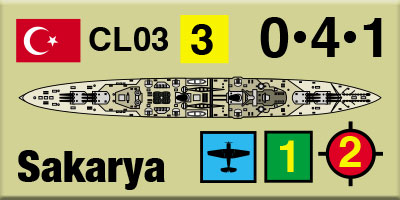
The Black Sea did not see a lot of naval action during the Second World War, so in terms of game-play Black Sea is very similar to Sea of Iron, which is set on the Baltic. Like the Baltic Sea, the Black Sea is not very large, and during the Second World War was isolated from other theaters of war. The Soviet Union maintained a large Black Sea Fleet, mostly of older, refurbished warships with new ones beginning to join them or still under construction.
The Black Sea Fleet includes an elderly battleship and four equally-decrepit old cruisers, and some Great War-era destroyers. Two modern, if undersized and under-armed, new heavy cruisers have just joined the fleet, which is also starting to receive modern (if poorly-designed) destroyers. Many more new ships are on the slipways, including a massive new super-battleship.

Romania joined the German sneak attack on the Soviet Union in June 1941, and fielded a single squadron of rather elderly destroyers. Otherwise, the Axis had no appreciable surface forces on the Black Sea. Romania, flush with petro-dollars, came close to purchasing a much larger surface navy before the war: new Italian-built armored cruisers and scout cruisers, and surplus British warships. These plans never came to fruition in reality, but they can in the game.
On the southern shore, neutral Turkey did maintain a fleet built around the 30-year-old battle cruiser Yavuz, with some modern destroyers built in Italy, and a pair of ancient “cruisers” good for nothing more than training. Britain’s Royal Navy seized four more modern destroyers under construction in British shipyards; these show up in Black Sea as well. But while the Red Navy considered the Turks a likely opponent in a future war, even transferring a battleship from the Baltic to the Black Sea to offset the Turkish battle cruiser, Turkey would remain neutral until joining the Allies during the war’s last months but not participating in any fighting.
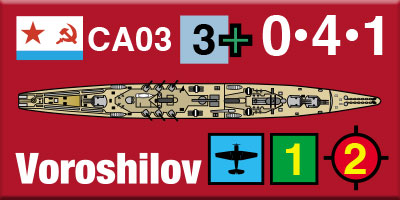
Like the Romanians, the Turks also looked to modernize their fleet. They sought a pair of cruisers from British yards, but with the British government trying to wrangle stricter international limits on cruiser construction, they blocked the deal. The yard then offered a battleship instead, which with the logic only possible in international diplomacy, somehow did not count as arms proliferation. Turkey gets all of those in Black Sea.
Daily Content includes no AI-generated content or third-party ads. We work hard to keep it that way, and that’s a lot of work. You can help us keep things that way with your gift through this link right here.
Black Sea includes all of the surface battles that took place on the Black Sea during the Second World War; there were not many of them. There were many more situations where one side or the other deployed their surface fleet and their opponents declined to interfere: during the sieges of Odessa and Sevastopol in 1941 and 1942, or the Axis evacuation of Crimea in 1944. We of course look at how things might have played out had they done so (usually, they had good reasons to decline to interfere).
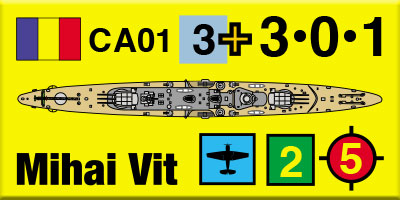
As in Sea of Iron and Horn of Africa (our games based on the Baltic and Red Seas, respectively), we turn to operations that could have taken place, but did not. Chief among those is the participation of Turkey on the Axis side, which adds airbases all along the southern rim of the Black Sea, and a small fleet that’s pretty crapulent, but it exists and that has to be taken into account by the Soviet side.
Once the modern, never-completed or -purchased ships are added to the mix, then things get more intense. The Black Sea is not very big, and those fast Romanian or Turkish cruisers can dash across it very quickly. Of course, that goes both ways, and those shiny new Soviet cruisers (and that deathstar-like new battleship) can be right off the Bosphorus ready to cause mayhem in an eyeblink as well.
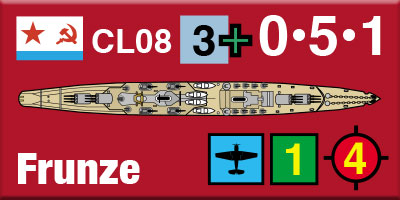
The scenario set is framed in the story-arc structure of all our recent naval games, so every operational scenario (those ones that take place on the map of the Black Sea) is accompanied by at least one corresponding battle scenario (the ones that take place just on the Tactical Map, where ships shoot at each other with guns and torpedoes, and sometimes blow up so you can make explosion sounds).
In the historical campaign, the Axis is vastly outgunned in terms of surface ships: four Romanian destroyers, one of them hampered by defective engines, face off against a Soviet surface fleet with a battleship, a quintet of cruisers and several dozen destroyers. That disparity limited the activities of the Romanian flotilla and the Axis side relied on airpower to influence events at sea, with mixed success.

Things get more interesting when you add ships planned by the Black Sea powers, but never actually built (or in this case, purchased from foreign shipyards). Romania picks up a pair of Italian-designed armored cruisers, two Italian-designed scout cruisers and a second quartet of destroyers from the same source. Thanks to oil revenues, Romania had hard currency in the years before the Second World War and was very willing to spend it on modern arms – but the marketplace could not supply all the desired weapons as larger nations prepared for war and either embargoed exports or bought up all production.
The scenario set with the new and improved Romanian fleet changes the strategic situation profoundly. In the actual campaign, the Romanians were chiefly concerned with protecting coastal traffic from the big Romanian port at Constanta down the western coast of the Black Sea to Istanbul and the Turkish Straits. This new Italian-built fleet, with its very fast but lightly-protected cruisers, is clearly intended to take the war into Soviet waters rather than serve as convoy escorts. And in the scenarios, that’s what they do: steam into the central and eastern Black Sea in search of Soviet transport traffic and in support of Axis land operations. They’re still out-gunned by the Soviets, but they can make a fight of it particularly with strong air support (which may or may not arrive – as in the Mediterranean theater, the German air force is not always willing to undertake missions in support of its nominal allies).

Turkey’s fleet – the historical one, though it saw no action in the Second World War – is built around the aging and partially modernized battle cruiser Yavuz, the former German Goeben. She’s supported by a pair of decrepit pre-Great War protected cruisers and a couple of ancient gunboats, also veterans of the Great War. The only modern units are four Italian-built destroyers, export versions of the Folgore class.
The scenario set with that fleet sees the Turks in better relative position against the Soviets than the Romanians, and they do possess a somewhat more potent air force in relative terms (though still no match for the Red Air Force). They are out-gunned all the same, but at least Yavuz has the speed to flee from the Soviet battleship and is more powerful than the Soviet cruisers – just as in the last war.
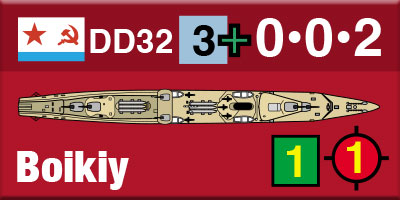
That dynamic changes with the additional Turkish ships projected but not actually built: a battleship of the modern King George V class, a pair of Edinburgh-class light cruisers and four destroyers of the Demirhisar class, export versions of the British I-class. Those last ships were actually built but seized by the Royal Navy upon completion; one would have thought the Turks had learned their lesson about British shipyards in 1914.
The new Turkish battleship is easily the most powerful warship on the Black Sea, and will rule the night. By day, the Red Air Force holds the upper hand – but like that of the Germans, it shows up when it feels like it. But the Black Sea Fleet does eventually receive a super-battleship, the badly-constructed but awesomely-armed Sovetskaya Ukraina. This massive ship is superior to anything in European waters, matched (on paper, at least) only by the huge American and Japanese battleships for size and firepower. The Turks and Romanians must fear her, the German Air Force (which becomes far more interested in sinking such a prestige target) not so much.
As re-worked, Black Sea becomes the type of historical study-with-game-pieces I’d like to see us continue to make. If the Mediterranean is a bathtub, then the Black Sea is a teapot: it’s hard to miss the enemy on this small sea.
Click here to join the Gold Club.
See your Gold Club Insider newsletter for ordering information.
Sign up for our newsletter right here. Your info will never be sold or transferred; we'll just use it to update you on new games and new offers.
Mike Bennighof is president of Avalanche Press and holds a doctorate in history from Emory University. A Fulbright Scholar and NASA Journalist in Space finalist, he has published a great many books, games and articles on historical subjects; people are saying that some of them are actually good.
He lives in Birmingham, Alabama with his wife and three children. He will never forget his Iron Dog, Leopold. Leopold feared ocean waves.
Daily Content includes no AI-generated content or third-party ads. We work hard to keep it that way, and that’s a lot of work. You can help us keep things that way with your gift through this link right here.
|
